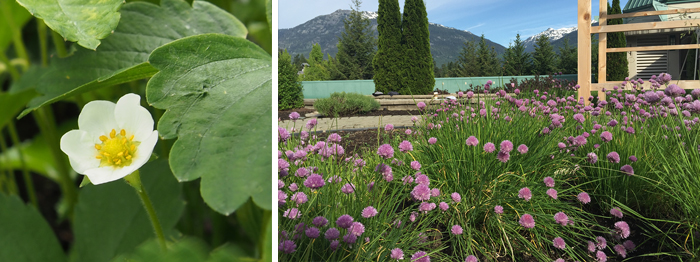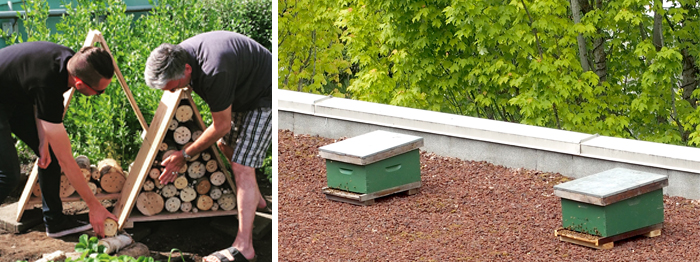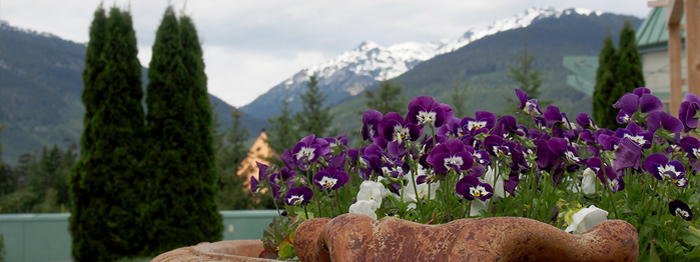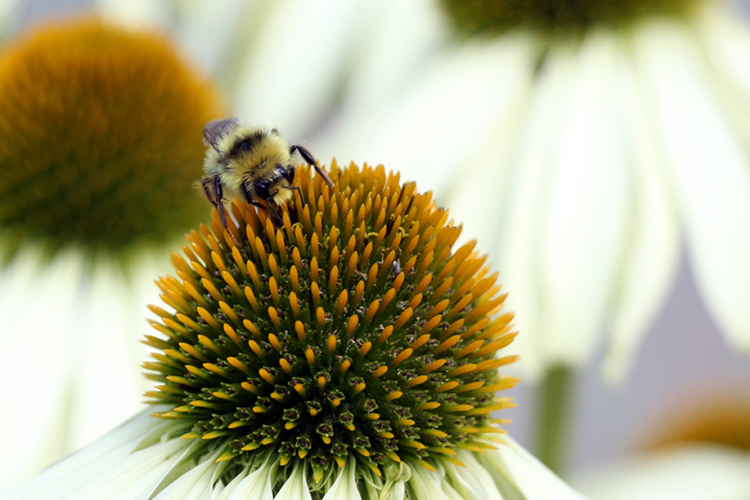

LEFT: A Local Farmont honey bee. RIGHT: Whistler’s first Fairmont Chateau bee lodgings.
There are two new Fairmont hotels in Whistler, built exclusively for one of the town’s most important temporary workforces: the bees.
To help launch a new Wild For Bees partnership, Fairmont hotels and resorts across Canada are building these “bee hotels” to provide urban habitat for mason bees- a type of non-stinging, solitary bee that act as key pollinators for food crops grown in the Sea to Sky corridor.
“I jokingly call them ‘Whistler-Boy’ bees,” says the Chateau’s Michelle Leroux, “because they don’t have a queen, they like to live alone, and they spend all day bouncing around outside.”
The bee hotels are just holes drilled into wooden rounds collected into a nice wooden A-frame structure (made from reclaimed wood) built in the hotel’s rooftop garden amongst an assortment of flowers, herbs and berry gardens that should make for a comfortable, luxurious stopover spot. Despite common misconceptions, mason bees are very small and often undetectable, simply laying eggs, pollinating flowers and plants and continuing on their way once their eggs are hatched.

Rooftop garden = bee paradise.
As pesticide-use, disease and monoculture farming continue to decimate bee populations around the world, initiatives to help any and all bees become more important every year. Anyone can build their own bee hotel with help from the Fairmont’s handy guide. With a thriving local farmers’ market and many of Whistler’s best restaurants serving locally sourced produce and ingredients, the more healthy, happy bees we have pollinating the area the better.
Sticking with the locally sourced concept, a more secluded area of the Chateau Whistler rooftops will also be home to 180,000 honeybees this summer, part of an ongoing bee sustainability program that has been in place since 2013. Each spring, Steve Gourley of GoldStrike Honeybee Co brings in thousands of bees for a summer vacation of gathering Whistler pollen and creating special Chateau Whistler honey.

LEFT: Building the bee hotel. RIGHT: Honey bees are a bit more territorial so their hives are kept on a separate area of the roof.
“I bring in new queens each year, because two-year queens are more flighty and more inclined to take off.” Steve explains, adding that so far all his bees have stayed put and thrived. “There are lots of flowers in the Upper Village, bees generally collect within three kilometres of home so they will venture down to the main Village if they need.”
So far the operation has produced about 90 pounds of local honeycomb each year (the honey is served on-site in specialty dishes and cocktails within the hotel) and the bee populations have more than doubled each summer. “You never know how much nectar and pollen Whistler will have each summer so I put a manageable number of bees up there,” Steve says. “Twelve hives times 15,000 bees each [180,000 total] and by the end of the summer there will be over 500,000 bees up there.”
The transient mason bees will migrate south before winter and each autumn Steve returns his honeybees back to the drier, more bee-friendly climate of Lillooet. “Bees don’t ski very well,” he explains.
Of course, if they add some tiny hot tubs and spas to those bee hotels who knows what could happen.
Get more info on the worldwide decline of bees . As always, you can find all the info you need on Whistler’s human hotels and everything else about Whistler over at Whistler.com. You better bee-lieve it.

A nice place to be a bee. The initiative is a joint venture between Fairmont Resorts & Hotels, Sustainable TO Building & Architecture, Burts Bees and Pollinator Partnership Canada.


